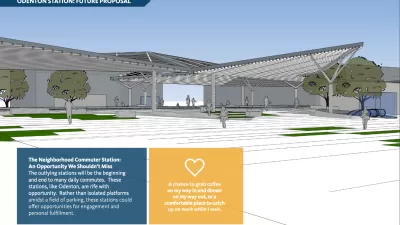Expanding rail service to more communities in Maryland and D.C. could enhance the benefits of Virginia's recent investments in intercity rail.

On the heels of Virginia's significant investments in intercity rail, a business community think tank calls for a "regional rail vision" that includes Maryland and the District of Columbia that would connect the entire region and maximize the benefits of Virginia's work on rail connectivity, writes Wyatt Gordon in the Virginia Mercury.
The goal is a regional rail service that lets commuters travel directly to D.C. and Baltimore from as far south as Richmond without changing trains, which Representative Don Beyer of Alexandria hopes will translate into a "big increase in ridership." Expanded rail service could "translate into big bucks for households and government coffers across the region." Increased connectivity could yield significant economic benefits for the region and boost access to affordable housing, evening out the pressure of the region's high cost of living. "If convenient commutes become a truly regional commodity, home prices closer to the Capitol may also slow their rapid staggering ascent."
"What we’re trying to do is to create more amenable communities to live or create jobs in throughout our region out of places that today are largely inaccessible unless you drive a car like Fredericksburg or Frederick, Maryland," Greater Washington Partnership's vice president of transportation, Joe McAndrew, told the Virginia Mercury. A major challenge for the regional vision is working across jurisdictions. "We are a complicated region with a lot of different governance structures and don’t always get along," Virginia Passenger Rail Authority board member Sharon Bulova said, "but we are able to come together and get things done."
FULL STORY: Regional rail vision aims to stitch Virginia, Maryland and D.C. closer together

Alabama: Trump Terminates Settlements for Black Communities Harmed By Raw Sewage
Trump deemed the landmark civil rights agreement “illegal DEI and environmental justice policy.”

Planetizen Federal Action Tracker
A weekly monitor of how Trump’s orders and actions are impacting planners and planning in America.

The 120 Year Old Tiny Home Villages That Sheltered San Francisco’s Earthquake Refugees
More than a century ago, San Francisco mobilized to house thousands of residents displaced by the 1906 earthquake. Could their strategy offer a model for the present?

In Both Crashes and Crime, Public Transportation is Far Safer than Driving
Contrary to popular assumptions, public transportation has far lower crash and crime rates than automobile travel. For safer communities, improve and encourage transit travel.

Report: Zoning Reforms Should Complement Nashville’s Ambitious Transit Plan
Without reform, restrictive zoning codes will limit the impact of the city’s planned transit expansion and could exclude some of the residents who depend on transit the most.

Judge Orders Release of Frozen IRA, IIJA Funding
The decision is a victory for environmental groups who charged that freezing funds for critical infrastructure and disaster response programs caused “real and irreparable harm” to communities.
Urban Design for Planners 1: Software Tools
This six-course series explores essential urban design concepts using open source software and equips planners with the tools they need to participate fully in the urban design process.
Planning for Universal Design
Learn the tools for implementing Universal Design in planning regulations.
Clanton & Associates, Inc.
Jessamine County Fiscal Court
Institute for Housing and Urban Development Studies (IHS)
City of Grandview
Harvard GSD Executive Education
Toledo-Lucas County Plan Commissions
Salt Lake City
NYU Wagner Graduate School of Public Service





























